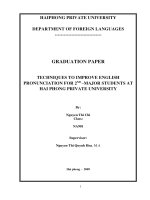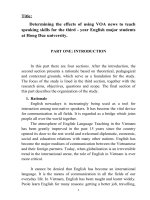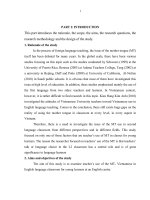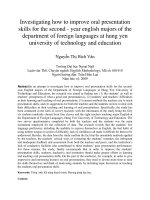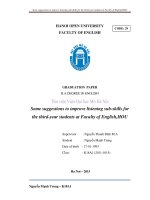Some techniques to improve english speaking skills for young learners at h123 english center
Bạn đang xem bản rút gọn của tài liệu. Xem và tải ngay bản đầy đủ của tài liệu tại đây (674.39 KB, 37 trang )
THU DAU MOT UNIVERSITY
FACULTY OF FOREIGN LANGUAGES
*************
GRADUATE PAPER
TITLE:
SOME TECHNIQUES TO IMPROVE ENGLISH SPEAKING SKILLS FOR
YOUNG LEARNERS AT H123 LANGUAGE CENTER.
Student name: Pham Nhat Ha
Student code: 1722202010073
Class: D17AVGD02
Course: 2017 – 2021
Major: English Teaching
Lecturer: Hoang Ho Trang
Binh Duong, DECEMBER/2020
TABLE OF CONTENT
TABLE OF CONTENT ..................................................................................... i
LIST OF TABLES ........................................................................................... iii
LIST OF FIGURES.......................................................................................... iv
ACKNOWLEDGEMENTS .............................................................................. 2
ABSTRACT ...................................................................................................... 3
CHAPTER 1: INTRODUCTION ..................................................................... 4
1.1 BACKGROUND TO THE STUDY........................................................ 4
1.2 STATEMENT OF THE PROBLEM:...................................................... 7
1.3 SIGNIFICANCE OF THE STUDY: ....................................................... 9
1.4 OBJECTIVES OF THE STUDY: ........................................................... 9
1.5 RESEARCH QUESTIONS ................................................................... 10
1.6 SCOPE AND LIMITATION: ............................................................... 10
CHAPTER 2: LITERATURE REVIEW ........................................................ 11
2.1. DEFINITIONS OF KEY TERMS ....................................................... 11
2.2. DATABASE ........................................................................................ 12
2.3. LITERATURE REVIEW .................................................................... 13
CHAPTER 3: METHODOLOGY .................................................................. 16
3.1 METHODOLOGY................................................................................ 16
3.2 DATA ANALYSIS PROCEDURE...................................................... 16
CHAPTER 4: RESULTS AND DISCUSSION .............................................. 17
4.1. RESULTS OF THE RESEARCH ....................................................... 17
4.1.1. Findings ....................................................................................... 17
4.1.2. Results.......................................................................................... 20
4.2. DISCUSSIONS .................................................................................... 25
CHAPTER 5: CONCLUSION AND RECOMMENDATION ...................... 27
5.1. CONCLUSION .................................................................................... 27
i
5.2. RECOMMENDATION ....................................................................... 28
REFERENCES ................................................................................................ 29
APPENDICES................................................................................................. 31
ii
LIST OF TABLES
Table 1: Why do we use YouTube to enhance English listening skills? ....... 17
Table 2: Some channels that the teacher show on YouTube to enhance young
learners English listening skills....................................................................... 19
iii
LIST OF FIGURES
Figure 1. Frame grab of “Super Simple Song” website’s main page.
( ................................................................................. 6
Figure 2. Frame grab of “The Singing Walrus” website’s main page.
( ) ......................................................................... 6
iv
STATEMENT OF AUTHORSHIP
Student full name:
Pham Nhat Ha
Student ID:
1722202010073
Title of paper:
Some techniques to improve English speaking skills
for young learners at H123 English center.
I hereby confirm that I am the sole author of the paper
presented.
Where the work of others has been consulted, this is duly
acknowledged in the paper’s bibliography. I have also not
consulted any other unnamed online sources. All verbatim or
referential use of the sources named in the bibliography has
been specifically indicated in the text.
Binh Duong, December/2020
1
Signature
ACKNOWLEDGEMENTS
First of all, I would like to thank you for all lecturers that instructed me to do
mine at Thu Dau Mot University. Besides, I would like to express my deeply
kind respects to Ms. Hoang Ho Trang, who has been dedicated to guiding me
through the process of writing the graduate paper. Thank you very much for
great cooperation during doing my report time.
Moreover, I sincerely thank the lecturers in the Department of Foreign
Languages at Thu Dau Mot University who conveyed their knowledge to me
during the years that I studied. With the knowledge acquired in the learning
process, it is not only a foundation for the research and reporting process but
also a valuable property for me to step into the future in a stabilized and
confident way.
Finally, I wish all the lecturers at Thu Dau Mot University profound health and
success in a noble career.
Sincerely,
Pham Nhat Ha
2
ABSTRACT
It is obvious that English is one of the most popular languages in the world
nowadays. In many countries, students are taught and encouraged to learn
English as a second language. Besides, because it is the main language in the
sciences, many programs of studies and research that we find in any given
scientific field will be written in English as well. So, that is the reason why
everyone needs to learn more languages for communication, business and
having good jobs in modern society, enhancing English skills is extremely
important for all the students nowadays, especially speaking skills is one of our
most common skills in communication activities. The result of this
investigation may also be valuable for individuals who are interested in this
field. The proficiency of speaking becomes one of the five skills that should be
acquired by every child in this 21century era. Mutually beneficial relationships
are a central undercurrent to accomplishment in Business this research is aimed
to investigate the teacher’s strategies, problems and solutions for teaching
speaking to young learners. A case study design was used in this study, and the
data were collected through observation, interview, and written document. The
data from these three instruments were analyzed qualitatively. This research
has found several strategies promoted by the lecturer when teaching speaking
to young learners. In the classroom activities, the lecturer used several
strategies such as, role play, watching videos, jazz chant, digital storytelling,
games, and repetition. The teachers might face several barriers in the classroom
such as reluctant students, missing pronunciation and lack of vocabularies;
however, the teacher can overcome those barriers by using various techniques
of teaching speaking to young learners, such as implementing media and
designing the lesson using topical-based syllabus.
Keywords: Teaching strategies, Speaking skill, EYL.
3
CHAPTER 1: INTRODUCTION
1.1 BACKGROUND TO THE STUDY
It is interesting news from the survey of PISA (Program for
International Students Assessment) conducted by OECD Organization
for Economic Co-operation and Development). Of the 510.000 students
of 15 to 16 years old who represent 28 million kids of 65 countries of
PISA members, it is surprising that Indonesia gets the highest of the
members in the field of ‘students feel happy at school’ and ‘students
make friends easily at school’. PISA assesses what student ‘knows’ and
‘able’ in mathematics, reading, and science. PISA assess the quality of
education of a certain country based on students of 15 to 16-year-old’s
skill in the three fields. Angel Gurria, OECD Secretary-General, says
that ‘more and more countries are looking beyond their own borders for
evidence of the most successful and efficient policies and practices.
Indeed, in a global economy, success is no longer measured against
national standards alone, but against the best-performing and most
rapidly improving education systems. He shows that the education
system is the first page of national development that should be
recognized.
However, Indonesia student's achievement reported by PISA is not
definitely followed by their competency in mathematics, language, and
science. According to PISA, of the 65 countries, Indonesia is the lowest
score before Peru. Surprisingly, PISA reported that Shanghai-China is
the highest, followed by Singapore, Hongkong-China and China Taipei.
Based on the PISA 2012 it can be concluded that today’s Indonesia
education system is still far from the targeted goals. In addition, the
survey shows, first; school-based curriculum (KTSP) by which
CTL/PAKEM used an approach of teaching is successfully conducted,
proven by the fact that Indonesia’s student feels happier at school than
that of many other countries. Countries with the high score in
mathematics, language and science surprisingly get a lower score in the
field of student feel happy at school, e.g. Shanghai-China places in rank
4
order of 28, Singapore 12, Hongkong-China 21, and China Taipei 19.
Second; the position of Indonesia vis-à-vis other countries of PISA
members i.e. the lowest rank before Peru shows that on mathematics,
language and science our students do not learn very well. CTL/PAKEM
approach practically only resulted in students’ happiness and their
easiness of making friends at school. Third; students who get the high
score in mathematics, language and science really learn hard, strive for
studying and ignore happiness and relaxed atmosphere at the school.
Today’ s curriculum of 2013 implies that English considered as local
content, it is not meant that English is as second opinion or even erased.
English for the elementary school is optional, some schools, if it is
possible, can make it a local content or they may choose others such as
ICT, cultures or life skills. When English is chosen as local content of
school curriculum, teachers, learning media and other supporting
facilities should be provided.
Before children or young learners learn to speak foreign language as the
first of their output, young children listen to words, phrase or sentences
as their first input. This is the first home of foreign words they come in
and play in after their first language. Speaking i.e. pronouncing new
words is the first skill of all young learners’ activities teachers should
recognize.
There are some reasons why H123 (English Afterschool Center) at
school is conducted. Children who have an early start develop and
maintain some advantages in some areas of language e.g. listening
comprehension mostly benefits from this early start, pronunciation also
benefits in longer term. However, younger children learn the grammar
of more slowly than older learners, so that although starting earlier with
language learning they make slower progress. Furthermore, young
learners find it easier to learn languages than older students. Though
compared to adult learners, these young learners face obstacles that
adult learners do not. They are still developing physically and
intellectually; their emotional needs may be higher; and they are less
able of take responsibility for their own learning. I agree with the fact
that teaching English to young learner is more effective than that of
5
older learner. Learning English several years earlier will increase the
total number of years to spent learning the language. In other words,
young learners seem to have greater facility for understanding and
imitating what they hear than secondary school pupils.
Figure 1. Frame grab of “Super Simple Song” website’s main page.
( />
Figure 2. Frame grab of “The Singing Walrus” website’s main page.
( )
6
1.2 STATEMENT OF THE PROBLEM:
No one can deny that using English to communicate in modern life is
extremely essential for us. Living in a developing country, learning
English is becoming ever more necessary for students who are the
future generations of the country. Besides, it also offers many
opportunities for students to find stable jobs in the future. However,
English speaking skill is still one of the most difficult problems for
students when they talk to foreigners. Therefore, that is the reason why
I would like to study about the techniques to improve English speaking
skills for young learners at H123 English center.
What we have to keep in mind constantly when teaching young learners
is the fact that they are a mixed class with varied abilities, motivations
level, expectations, knowledge and different learning styles. Thus, we
have to vary our approaches and offer as much opportunity as possible
to make the whole class find a little something to hold on to, expand
and grow. To develop speaking skills basically need a closer look and
further discussion among the teachers of young learner so that they will
find guidelines to led students to get involved and interested in learning
foreign language.
Learning to communicate in a foreign language, English for instance, is
a process of very complex activities of language acquisition. For young
learners, to start learning a foreign language is like to start learning
one’s mother tongue. They need some more time to listen to a foreign
language in the classroom and they should have also more chances to
repeat some of the utterances they hear. According to Slattery and
Willis in their book of English for Primary Teachers, although
repetition of set phrases does not mean that children are acquiring
language, it is still very important. They argue that repetition prepares
children for meaningful communication in several ways i.e. by helping
them get used to saying English, by allowing them to practice the
intonation pattern, and by enabling them to gain confidence, especially
if the teacher gives a lot of praise. Accordingly, for teacher of H123 it
is suggested to open chances and more time for the learners to listen
7
words, utterances, set of phrases as a process of developing learners’
speaking skill.
Teaching young learners is actually not as difficult as we imagine, they
are like sponges, they absorb everything we say and how we say it. The
ability of teachers in pronouncing every words, phrase and sentences is
of vital important, since young learners will repeat exactly what they
hear. It is believed that what young learners has been learned at an early
stage is difficult to change later on. For this reason, the teacher can
apply the rules i.e. slowly and steadily, through continual and constant
revision and recycling. In addition, it should be cared by the teachers of
young learners i.e. the relaxed and positive atmosphere of young
learners’ classroom, as it is a decisive factor in achieving maximum
results. There are many varied activities e.g. dialogues, songs, poems,
rhymes, choral revision, and chants that can be adopted to grow
students’ speaking abilities as well as to build their pronunciation.
There should be paid more attention, when teachers of young learners
applied the above-mentioned tools into their teaching practice i.e. that
learners’ interaction as a way of learning. It means, teacher should
emphasize and open as much chances as possible for the learners to
practice pronouncing and speaking English either in the classroom or
out of.
To be able to use English in communication, children need to acquire
necessary vocabulary and structures. In the beginning stages of
language learning, new vocabulary should be presented orally with
extensive support of pictures, drawings, puppets, realia, video, and/or
mime, gesture, facial expressions or acting out. Miming driving a car
and presenting a picture of a car helps children grasp the meaning of
’drive’ and ’a car’ extremely quickly. So that, it is suggested that the
teacher of young learner prepares materials for teaching young learners
in the course of their pre-service teaching practice i.e. posters with
town plans, masks with animal faces, puppets, puzzles, paper birthday
cakes, birthday presents, balloons, videos that help all children learn the
names of dangerous sports for instance ’skydiving’, ’rock climbing’,
’rodeo riding’, ’scuba diving’ with big enjoyment.
8
Information gap activities provide appropriate opportunities for guided
communication activities, while role plays lead children from fully to
less controlled language use and prepare them for free speaking
activities. ’Talking on the phone’ or ’having tea’ will intrinsically
motivate children to take part in the activities because of the element of
game and fun associated with them; if the classroom atmosphere is
informal and non-competitive, the activities will help children get ready
for similar real-life contexts. Moreover, in such some activities children
don’t just use words, but also all other parts of speaking a language –
tone of voice, stress, intonation, facial expressions, which contributes
to achieving fluency.
1.3 SIGNIFICANCE OF THE STUDY:
As human beings, we seek to interact with each other daily. Therefore,
speaking is an important skill that allows us to receive, understand and
evaluate information. Besides, speaking also plays a significant part in
allowing an individual to perform tasks in the business environment
especially in international circumstances. Furthermore, we cannot
develop our listening ability unless we develop our speaking skills.
1.4 OBJECTIVES OF THE STUDY:
The study is to investigate how to help young learners improving
language speaking skill, special English. In this way, I choose a survey
questionnaire and an interview as good methods to collect more data
quickly. And as a future generation of the country, I cannot believe that
this issue doesn’t have a good way to solve it. Therefore, I will evaluate
approximately the rate of percent through the following research
questions and record exactly the answer through a short interview of
another language teacher.
9
1.5 RESEARCH QUESTIONS
a) Why do young learners need to improve speaking skills?
b) Some methods that teacher can use to teach speaking skills for young
learners in class.
1.6 SCOPE AND LIMITATION:
I started to get the data of teaching speaking skill methods from 20
English teachers at H123 (Afterschool English Center) during 2
months. Overview of the report arrangement includes 5 chapters and
each of them all have their responsibility.
10
CHAPTER 2: LITERATURE REVIEW
2.1. DEFINITIONS OF KEY TERMS
Speaking is an essential tool for communicating, thinking and learning.
Oral language is a powerful learning tool. It shapes, modifies, extends
and organizes thought. Oral language is a foundation of all language
development and therefore, the foundation of all learning. It is the base
for the other language strands. Speaking is the process of transferring
knowledge of converse and how to express one idea, thought, desire
and willingness into good pattern and ordinary speech to talk or
recognize another. In addition, according to Hybel, “speaking is any
process in which people share information, ideas and feeling, it involves
all of body language mannerism and style-anything that adds meaning
to a massage”. In Oxford Advanced Dictionary the definition of
speaking is “to express or communicate opinions, feelings, ideas, etc.,
by or as talking and it involves the activities in the part of the speaker
as psychological, physiological (articulator) and physical (acoustic)
stages.”
While according to another expert, Chaney, speaking is the process of
building and sharing meaning through the use of verbal and non-verbal
symbols, in a variety of contexts. Clark and Clark (1977) state that
speaking is fundamentally an instrumental act. Speakers talk in order to
have some effects on their listeners. They assert things to change their
state of knowledge. They ask them questions to get them to provide
information. They request things to get them to do things for them. They
promise, bet, warn, and exclaim to affect them in still other ways. The
nature of the speech act should therefore play a central role in the
process of speech production. Speakers begin with the intention of
affecting their listeners in a particular way, and then select and utter a
sentence they believe will bring about just this effect. Speaking,
therefore, appears to be divided into two types of activity-planning and
execution, utterers. Speaker firstly plan what they want to say based on
how they want to change the mental state of their listeners. They then
11
put their plan into execution, uttering the segments, words, phrases, and
sentences that make up the plan.
In planning what to say, speakers implicitly have a problem to solve
what linguistic devices they should select to affect the listener the way
they intend. The solution to this problem is not easy.
A technique for teaching speaking is a replicable learning activity
organized by the teacher with the intended purpose of the lesson and
according to the principles of communicative-oriented teaching
method. This definition shows that a technique always corresponds to
one of the objectives of the lesson, allowing the teacher and the learners
to resolve a certain task of language instruction. An organizational and
pedagogical technology differs from the “technique” in that it is a
description of the “step by step” process to smoothly implement the
technique overcoming cognitive difficulties in learners towards the
most effective achievement of learning objectives. A technique can be
compared to the name of the Yorkshire pudding recipe while the
organizational and pedagogical technology is the description of the
“best Yorkshire pud secrets”. In the description of the organizational
and pedagogical technologies, the “secrets of Yorkshire pudding” are
just a metaphor. This comparison shows that the value of organizational
and pedagogical technologies in bringing about the full potential of a
teaching technique is really crucial. Without the technological
organization of teaching, the use of even the most well-known and
reliable teaching techniques with very spectacular “ingredients” may be
doomed to failure.
In other words, a “technique” is the name of a procedure while a
“technology” is the means to run it smoothly.
2.2. DATABASE
Concerning the method, the questionnaire was employed for this study.
According to Wikipedia ( />questionnaire is a research instrument consisting of a series of questions
(or other types of prompts) to gather information from respondents.
12
Besides, questionnaires have advantages over some other types of
surveys in that they are cheap, do not require as much effort from the
questioner as verbal or telephone surveys, and often have standardized
answers that make it simple to compile data. To help me get richer
information about the research, I make a decision to choose a survey
questionnaire and an interview as an instrument for collecting data
which are the most effective ways to collect results quickly and easily.
2.3. LITERATURE REVIEW
The aim of this chapter is to review the literature relevant to the issues
under study. The literature review consists of five sections: section one
deals with introduce, section two focuses on the literature review,
section three mentions about the approaches to the teaching of speaking,
section four results and discussion, the last section is about conclusion
and recommendation.
The problems in teaching and learning English speaking
It is a commonly recognized the fact that achieving proficiency in
foreign language speaking in classroom conditions is not an easy task.
Even advanced learners often finish a language course with the
conviction that they are not sufficiently prepared for speaking beyond
the classroom.
This difficulty results basically from the character and inadequate
frequency of speaking opportunities in the classroom in comparison to
the abundance of natural varieties and genres of oral communication.
In fact, selecting the most appropriate types of spoken discourse for
classroom practice in a particular language course is a very hard
decision which, unfortunately, hardly ever reflects the natural
occurrence and distribution of communicative situations.
Other problems that are commonly observed in the language classroom
are related to individual learner personalities and attitudes to the
learning process and learning speaking in particular. They can be shown
as the inhibition which is the fear of making mistakes, losing face,
criticism or shyness. The second thing is that learners have problems
13
with finding ideas to speak, formulating opinions or relevant comments.
The third one is the low or uneven participation and this is often caused
by the tendency of some learners to dominate in the group. The last one
is about the mother-tongue use which is particularly common in less
disciplined or less motivated classes, learners find it easier or more
natural to express themselves in their native language.
In addition, as many teachers‟ observations indicate, the above
situations occur in language classrooms regardless of the level of
proficiency or the number of students in the group. Moreover, every
learner enters any learning and communicative environment with his or
her entire personality additionally shaped by their prior learning and
communicative experiences, both positive and negative. This individual
dimension is particularly noticeable among older and more advanced
learners who often have a good insight into the nature of their individual
difficulties, an accurate assessment of the skills they have already
developed and, consequently, clearly defined needs.
The fact is that English is used for communication among people in the
world. As an international language, it is necessary for us to learn it.
But we know that studying English as a foreign language is not easy.
Therefore, the students should be taught English from elementary level.
English skills are
divided into four skills. They cannot be separated each other. So, in
teaching and learning process the four skills must be taught in
integration. In the process, it is possible that many problems rise in
every skill and need the attention to give the solution for it.
Finally, the non- linguistic problems are limited reference, limited time
in practicing English, less frequency in studying English, never have
partner in practicing English, never have chance to speak English with
native speaker, simply shame and there is no habit in practicing English.
In coping with the problems there are no significant different ways,
these are asking to friend or teacher, opening the dictionary, practicing
14
with partners, reviewing the lesson at home, and trying to always be
active in speaking activities
15
CHAPTER 3: METHODOLOGY
3.1 METHODOLOGY
This study is designed as qualitative research which is to show the
measure method to teach English speaking skill for young learners..
Firstly, I will make a survey questionnaire with twenty teachers who
teach at H123- Afterschool English Center including ten students in the
Teaching English major at Thu Dau Mot University, I will organize four
questions for taking opinions from other teachers who are randomly
selected around the center. Especially, the interview consists of the four
following questions:
• Is English important for us nowadays? Why?
• What do you usually use YouTube for?
• What kinds of games do you organize for students to improve
their speaking skills?
• For you, what are the benefits of using activities in enhancing
English speaking skills?
3.2 DATA ANALYSIS PROCEDURE
The results of the study are presented in tables, and explanations are
provided appropriately. Together with the data from the questionnaires,
the students’ opinions through the interview are presented.
16
CHAPTER 4: RESULTS AND DISCUSSION
4.1. RESULTS OF THE RESEARCH
4.1.1. Findings
Table 1: Why do we use YouTube to enhance English listening skills?
Question 1: I would like to know the reason why do you choose
YouTube to enhance English listening skills for young learners.
Read the sentences and tick () a sentence when you:
[Notes: SD: Strongly Disagree; D: Disagree; N: Neutral; A: Agree; SA:
Strongly Agree]
❖ Result:
Generally, the majority of teachers at H123 center express positive
attitudes towards using YouTube to enhance English listening skills
with higher percentages of agreement (A) and strong agreement (SA).
According to Table 1, the responses show that most teachers rank the
reasons for using YouTube in enhancing English listening skills.
Specifically, 100% of the participants strongly agree that YouTube is
the best place that has a lot of foreign channels that can help the young
students pronounce vocabulary correctly and the teachers can pause and
17
rewind YouTube English videos whenever they need to. 80% is the
highest proportion of participants expressing their agreement or strong
agreement on the variety of materials on YouTube that can promote
learning. 60% consider YouTube as the best tool that there are many
different levels for the students to practice while 50% providing a lot of
information in easy-to-understand ways. Between 40% and 20% are the
percentages of the rest of the reasons why we use YouTube to enhance
English listening skills.
Noticeably, 10% of the teachers answer that they did not know exactly
YouTube can provide a lot of information in easy-to-understand ways.
18
Table 2: Some channels that the teacher show on YouTube to
enhance young learners English listening skills.
Question 2: I would like to know the measure of using some popular
channels that you can search on YouTube to enhance English listening
skills. Read the sentences and tick ( ) a sentence when you:
1)
N: Never
2)
R: Rarely
3)
S: Sometimes
4)
O: Often
5)
U: Usually
❖ Result:
Generally, the table shows that there is a big difference in the measure
of using YouTube for several channels, namely Pink Fong, Super
Simple Song, Cocomelon, Dream English Kids Songs, The Singing
Walrus.
According to Table 2, 88% is the highest proportion of participants
watching “Super Simple Song” channels on YouTube. A massive 80%
of the participants express that they usually watch “The Singing
19
Walrus” channel on YouTube. Similarly, the rate of participants who
sometimes watch “Dream English Kids Songs” is 72% and the rate of
participants who often watch “Pink Fong” is 70%. Besides, 40% is the
rate of participants that they sometimes watch “Cocomelon” while 36%
is the rate of participants that they usually watch “Cocomelon” on
YouTube. In the same way, 26% of the participants consider that they
usually watch “Pink Fong” channels and 24% is the rate of the
participants that they often use “Cocomelon”. Also, the measure of the
participants who often watch “The Singing Walrus” channel is 20%
while the rate of the participants who use “Dream English Kids Songs”
is just under 20% (approximately 16%). The minority of the participants
who often watch “Super Simple Song” is 12%. Significantly, 8% is the
rate of the participants who watch “Dream English Kids Songs” rarely.
Moreover, a modest 4% of the participants who sometimes watch Pink
Fong and usually watch “Dream English Kids Songs” channels.
4.1.2. Results
Is English important for us nowadays? Why?
• I would say that English is really important for us nowadays
because people who can speak English well will practically have more
job opportunities. In the foreign companies, businesses need employees
who can communicate fluently with English-speaking partners and
clients. Especially, in the United States or other English-speaking
countries, people who cannot speak English are at a real economic
disadvantage.
• In my opinion, English is very essential for us in modern life
because English is the main language of science and technology.
English speakers will have more opportunities to work with others in
these fields and to share ideas or innovations effectively.
• Yes, it is. For me, being able to speak English makes it easier to
travel because English is spoken as a first or second language in so
many different countries around the world. Besides, it is always easy to
20


